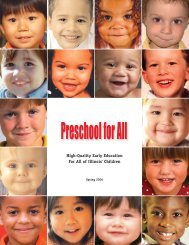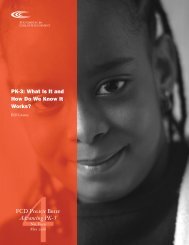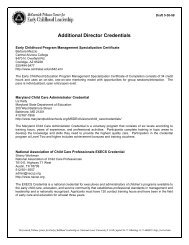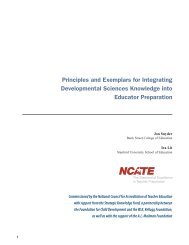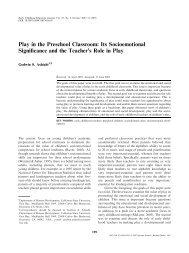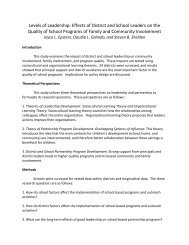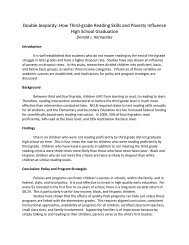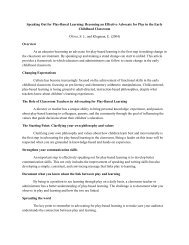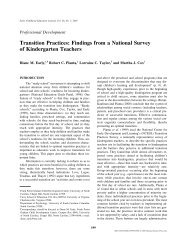<strong>Pre</strong>school Policy Brief March 2004N<strong>in</strong>e Keys to Effective <strong>Pre</strong>k<strong>in</strong>dergarten <strong>Standards</strong>Many of the conditions needed <strong>for</strong> successful standards-based re<strong>for</strong>m apply to all grade levels, <strong>in</strong>clud<strong>in</strong>g prek<strong>in</strong>dergarten.This section describes n<strong>in</strong>e keys to effective standards. For each, it addresses the particular considerations or conditionsthat must be addressed to make child outcome standards appropriate and effective <strong>in</strong> the preschool years.1<strong>Standards</strong> should represent values that make senseto children’s families and communities.<strong>Standards</strong> identify the knowledge and skills that teachersshould spend the most time on. They def<strong>in</strong>e not only sharedexpectations, but also shared notions about what matters <strong>for</strong>children. 6 In this way, standards represent the values of thepeople who set them. 3For preschoolers… When young children are <strong>in</strong>volved,families and communities tend to be especially concernedabout the values that underlie outcome standards. After all,it is dur<strong>in</strong>g the early years that children beg<strong>in</strong> to developempathy and understand basic moral precepts. It is dur<strong>in</strong>gthe preschool years that children <strong>for</strong>m the secure relationshipswith adults that allow them to venture off and explore; beg<strong>in</strong>to <strong>in</strong>teract cooperatively with peers; and slowly <strong>in</strong>crease theircapacity <strong>for</strong> self-regulation. Early childhood programsthere<strong>for</strong>e track children’s progress across the developmentalspectrum, <strong>in</strong>clud<strong>in</strong>g the very important social and emotionaldoma<strong>in</strong>s. Expectations of children tend to reflect deeply heldassumptions and values. It is there<strong>for</strong>e especially important toengage families and communities <strong>in</strong> discussions that help toshape preschool standards.What Young <strong>Child</strong>ren Know& Can Do“Armed with new methodologies, psychologists began toaccumulate a substantial body of ideas about the remarkableabilities that young children possess that stands <strong>in</strong> starkcontrast to the older emphases on what they lacked. It isnow known that very young children are competent,active agents of their own conceptual development...”“Young children are actively engaged <strong>in</strong> mak<strong>in</strong>g senseof their worlds. In some particular doma<strong>in</strong>s, such asbiological and physical causality, number, and language,they have strong predispositions to learn rapidly andreadily. These predispositions support and may evenmake possible early learn<strong>in</strong>g and pave the way <strong>for</strong>competence <strong>in</strong> early school<strong>in</strong>g.”2<strong>Standards</strong> should be evidence-based.<strong>Standards</strong> are sets of detailed explanations and illustrations ofwhat children should know and be able to do <strong>in</strong> a particulararea, by a specific time <strong>in</strong> a child’s education. <strong>Standards</strong> needto be evidence-based. That is, they need to be based on thebest evidence of what young children can learn. 11In addition, they should be based on research show<strong>in</strong>g thatparticular outcome standards, implemented as part of thecurriculum and ongo<strong>in</strong>g teach<strong>in</strong>g and assessment, cancontribute to positive outcomes <strong>for</strong> the children <strong>for</strong> whomthey are <strong>in</strong>tended.For preschoolers… Research has shown that youngchildren are more capable than was once thought. 12Psychologists and cognitive scientists have shown thatpreschoolers are active learners who are predisposed tocerta<strong>in</strong> k<strong>in</strong>ds of knowledge. But <strong>in</strong> many areas there is notenough evidence to identify reasonable expectations <strong>for</strong> youngchildren. Research is particularly th<strong>in</strong> <strong>in</strong> relation to standards<strong>for</strong> children with disabilities and other special needs.In the absence of such research, exist<strong>in</strong>g sets of pre-Kstandards rely on the practical experience of early childhoodeducators and the academiccontent taught <strong>in</strong> higher grades.In many cases, these twoperspectives are not properlybalanced, result<strong>in</strong>g <strong>in</strong>standards that eitherunderestimate oroverestimate thelearn<strong>in</strong>g potentialof young children.4<strong>National</strong> Research Council, How People Learn: Bra<strong>in</strong>,M<strong>in</strong>d, Experience, and School, 1999.
<strong>Pre</strong>school Policy Brief March 2004How Many <strong>Standards</strong>?One of the criticisms of K-12 standards has been the sheernumber of standards and benchmarks. Accord<strong>in</strong>g to aconservative estimate, it takes an average of five hours tocover one content benchmark. Address<strong>in</strong>g all standards andbenchmarks identified by states and districts would requireK-12 systems to become K-22 systems! 17Early childhood educators and policy makers should identifya reasonable set of expectations and outcomes that aremean<strong>in</strong>gful and represent the critical learn<strong>in</strong>g necessary<strong>for</strong> later development.3<strong>Standards</strong> should be comprehensive.<strong>Standards</strong> should cover the full range of knowledge, skills,habits, attitudes, and dispositions that children need tomaster. They should encompass all of the major branchesof knowledge that contribute to children’s capacity toreason, create, communicate, solve problems, and ma<strong>in</strong>ta<strong>in</strong>their health. 13 Comprehensive standards <strong>in</strong>clude contentstandards (def<strong>in</strong><strong>in</strong>g the range of knowledge and skillsthat children should master) and per<strong>for</strong>mance standards(def<strong>in</strong><strong>in</strong>g how it can be demonstrated that children havemet the standards).For preschoolers… To be comprehensive, outcomestandards must take <strong>in</strong>to account the five doma<strong>in</strong>s of schoolread<strong>in</strong>ess identified by the <strong>National</strong> Education Goals Panel. 14,1• Physical well-be<strong>in</strong>g and motor development• Social and emotional development• Approaches toward learn<strong>in</strong>g• Language development• Cognitive and general knowledgeYoung children’s learn<strong>in</strong>g is heavily dependent on thedevelopment of language, th<strong>in</strong>k<strong>in</strong>g, and cognitive andsocio-emotional skills that are taken <strong>for</strong> granted <strong>in</strong> highergrades where the primary emphasis is placed on content.In early childhood, the development of these foundationalskills (skills that lay the foundation <strong>for</strong> later learn<strong>in</strong>g) is justas important as mastery of content matter. For example,there is a grow<strong>in</strong>g body of evidence <strong>in</strong>dicat<strong>in</strong>g that cognitiveand emotional self-regulation play a key role <strong>in</strong> <strong>in</strong>fluenc<strong>in</strong>grates of learn<strong>in</strong>g and school read<strong>in</strong>ess. 15,16 For preschoolers,standards that address foundational skills should there<strong>for</strong>ebe articulated with as much specificity as the contentstandards.4<strong>Standards</strong> should be specific, yet still allowflexibility as teachers implement them.If a standard covers a broad area of learn<strong>in</strong>g or developmentit must to be broken down <strong>in</strong>to more narrow benchmarks.However, the benchmarks should not be too specificto allow <strong>for</strong> teachers’ flexibility <strong>in</strong> implement<strong>in</strong>g differentcurricula or us<strong>in</strong>g different <strong>in</strong>structional strategies. Forexample, a benchmark that says: “retells from memory afamiliar book about farm animals” appears overly specific.For preschoolers… In some areas, the lack of specificitythat can weaken standards <strong>for</strong> older students can alsounderm<strong>in</strong>e preschool standards. There is a particularlystrong need <strong>for</strong> specificity as standards and benchmarksare written <strong>for</strong> preschool language and literacy development.18 As one recent study observed, “age appropriate andwell-written clear benchmarks have a crucial role <strong>in</strong> br<strong>in</strong>g<strong>in</strong>geffective literacy practices to preschool programs.” 19<strong>Pre</strong>school outcomes need to be stated <strong>in</strong> terms of skills,rather than activities.In other areas of early learn<strong>in</strong>g, the requirement of specificitycan be problematic because many of young children’s competenciesare develop<strong>in</strong>g <strong>in</strong> concert. It is often difficult toisolate learn<strong>in</strong>g outcomes <strong>in</strong> a s<strong>in</strong>gle area. It is often betterto describe a learn<strong>in</strong>g outcome <strong>in</strong> a way that is specific to aparticular doma<strong>in</strong> of development, even if that meansrepeat<strong>in</strong>g the standard (perhaps with different emphasis)as it relates to another doma<strong>in</strong>. This will help teachers tobetter focus on the outcome of a child’s learn<strong>in</strong>g <strong>in</strong>choos<strong>in</strong>g appropriate assessments, materials and activities.For example, while be<strong>in</strong>g able to participate <strong>in</strong> dramaticplay is a learn<strong>in</strong>g outcome that comb<strong>in</strong>es a young child’sachievements <strong>in</strong> the areas of socio-emotional, cognitive,and language development, support<strong>in</strong>g each of these areaspresents teachers with different demands <strong>in</strong> terms ofassess<strong>in</strong>g child per<strong>for</strong>mance or plann<strong>in</strong>g <strong>in</strong>structional<strong>in</strong>terventions.What Are Benchmarks?<strong>Standards</strong> are often broken down <strong>in</strong>to more specificbenchmarks that can be demonstrated and measured.An example: “Develops personal and social competence”is a standard whose aim is clarified by the benchmark,“Listens to others and participates <strong>in</strong> group ef<strong>for</strong>ts.”5




